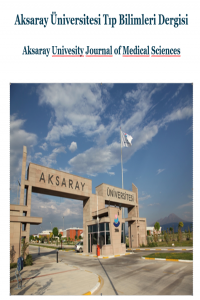COMPARING OF SURGICAL TECHNIQUES IN PILONIDAL SINUS DISEASE
Background: Pilonidal sinus is commonly encountred in the sacrococcygeal areas and effects daily activities and life quality. Several surgical techniques and methods have been explained for the treatment of pilonidal sinus. In this retrospective study, we aimed compare clinical outcomes and complications of these methods.
Material and methods: This retrospective study was performed over 136 sacrococygeal pilonidal sinus operations done between January 2014 and December 2015 in Ankara Atatürk Research and Training Hospital General Surgery Clinic-B.
Results:. Mean age of the patients was calculated as 26,10. 121 (89%) of the patients were male and 15 (11%) were female. Total excision and leaving to secondary healing was applied to 88, total excision and primary repair to 23, Karydakis Flep to 9, VAC application to 8 and Limberg Flep to 7 of the patients involved in this study. Mean period of hospitalisation of VAC Application was longer than other surgical methods (p0,001). Postoperative analgesia needs of patients that operated by Karydakis and Limberg Flep methods was less than other methods (p0,05). Postoperative complication ratio of flep techniques was higher than other methods (p
Anahtar Kelimeler:
Pilonidal sinus, flep techniques, primary, secondary, karydakis, limberg
___
- 1. Urhan MK, Kücükel F, Topgul K, Özer İ, Sari S. Rhomboid excision and Limberg flap for managing pilonidal sinus. Diseases of the colon & rectum. 2002;45(5):656-9.
- 2. Bozkurt MK, Tezel E. Management of pilonidal sinus with the Limberg flap. Diseases of the colon & rectum. 1998;41(6):775-7.
- 3. Bailey H, Ford D. Pilonidal Disease. ed: Zuidema GD, Yeo JC. Shackelford’s Surgery of the Alimentary Tract 5th Ed. Vol: 4. Philadelphia: Saunders; 2002.
- 4. Madhusudhan A, Swamy MD, Arif M. Pilonidal sinus-limberg versus karidakis flap our experience at SIMS, Shivamogga. International Surgery Journal. 2017;4(11):3641-5.
- 5. Abcarian H, Orangio GR. Complex Pilonidal Disease and Acute and Chronic Perineal Wounds: Point–Counterpoint. Complexities in Colorectal Surgery: Springer; 2014. p. 377-90.
- 6. Ertan T, Koc M, Gocmen E, Aslar AK, Keskek M, Kilic M. Does technique alter quality of life after pilonidal sinus surgery? The American journal of surgery. 2005;190(3):388-92.
- 7. Jaschke C, Mährlein R, Mangold G. Results of the Limberg transposition flap in the treatment of pilonidal sinus. Zentralblatt Fur Chirurgie. 2002;127(8):712-5.
- 8. Dwight RW, Maloy JK. Pilonidal sinus: experience with 449 cases. New England Journal of Medicine. 1953;249(23):926-30.
- 9. Akinci ÖF, Bozer M, Uzunköy A, Düzgün ŞA, Coşkun A. Incidence and aetiological factors in pilonidal sinus among Turkish soldiers. The European journal of surgery. 1999;165(4):339-42.
- 10. Brearley R. Pilonidal sinus a new theory of origin. British Journal of Surgery. 1955;43(177):62-8.
- 11. Kooistra HP. Pilonidal sinuses: review of the literature and report of three hundred fifty cases. The American Journal of Surgery. 1942;55(1):3-17.
- 12. AĞCA B, ALTINLI E, DURAN Y, MİHMANLI M. Pilonidal sinüs tedavisinde Limberg Flep ve primer onarımın karşılaştırılması. Çağdaş Cerrahi Dergisi. 2002;16(3):152-4.
- 13. Khaira H, Brown J. Excision and primary suture of pilonidal sinus. Annals of the Royal College of Surgeons of England. 1995;77(4):242.
- 14. Al‐Jaberi TM. Excision and simple primary closure of chronic pilonidal sinus. European Journal of Surgery. 2001;167(2):133-5.
- 15. Muzi M, Milito G, Nigro C, Cadeddu F, Farinon A. A modification of primary closure for the treatment of pilonidal disease in day‐care setting. Colorectal Disease. 2009;11(1):84-8.
- 16. Iesalnieks I, Fürst A, Rentsch M, Jauch K. Primary midline closure after excision of a pilonidal sinus is associated with a high recurrence rate. Der Chirurg; Zeitschrift fur alle Gebiete der operativen Medizen. 2003;74(5):461-8.
- 17. Cubukcu A, Gönüllü N, Paksoy M, Alponat A, Kuru M, Özbay O. The role of obesity on the recurrence of pilonidal sinus disease in patients, who were treated by excision and Limberg flap transposition. International journal of colorectal disease. 2000;15(3):173-5.
- 18. Kaya B, Uçtum Y, Şimşek A, Kutaniş R. Treatment of pilonidal sinus with primary closure. A simple and effective method. Turkish Journal of Colorectal Disease. 2010;20(2):59-65.
- 19. Jensen S, Harling H. Prognosis after simple incision and drainage for a first‐episode acute pilonidal abscess. British journal of surgery. 1988;75(1):60-1.
- 20. Horwood J, Hanratty D, Chandran P, Billings P. Primary closure or rhomboid excision and Limberg flap for the management of primary sacrococcygeal pilonidal disease? A meta‐analysis of randomized controlled trials. Colorectal Disease. 2012;14(2):143-51.
- 21. Biter LU, Beck GM, Mannaerts GH, Stok MM, van der Ham AC, Grotenhuis BA. The use of negative-pressure wound therapy in pilonidal sinus disease: a randomized controlled trial comparing negative-pressure wound therapy versus standard open wound care after surgical excision. Diseases of the colon & rectum. 2014;57(12):1406-11.
- 22. HOEHN JG, ELLIOTT JR RA, STAYMAN III JW. The use of Limberg flaps for repairing small decubitus ulcers. Plastic and reconstructive surgery. 1977;60(4):548-57.
- ISSN: 2757-6655
- Yayın Aralığı: Yılda 3 Sayı
- Başlangıç: 2020
- Yayıncı: Aksaray Üniversitesi
Sayıdaki Diğer Makaleler
Aksaray İlindeki Kistik ve Alveolar Ekinokokkozis Riski
Statin kullanımına bağlı pankreatik enzim yükselmesi-vaka sunumu
COMPARING OF SURGICAL TECHNIQUES IN PILONIDAL SINUS DISEASE
Ali Erdinç ÇİFTÇİLER, Serap ULUSOY
Keratokonusta in Vivo Lazer Tarayıcı Konfokal Mikroskopi Bulguları
Baskın Olmayan Elde Karpal Tünel Sendromu
Adnan Burak BİLGİÇ, Çetin Kursad AKPİNAR
Acil Servise Başvuran Burunda Yabancı Cisim Olgularına Yaklaşım
Buprenorfin/Naloksan Tek Dozuna Bağlı Yan Etkiler: Olgu Bildirimi
The Importance of Autophagy Mechanism as a Novel Therapeutic Target in SARS-CoV-2
